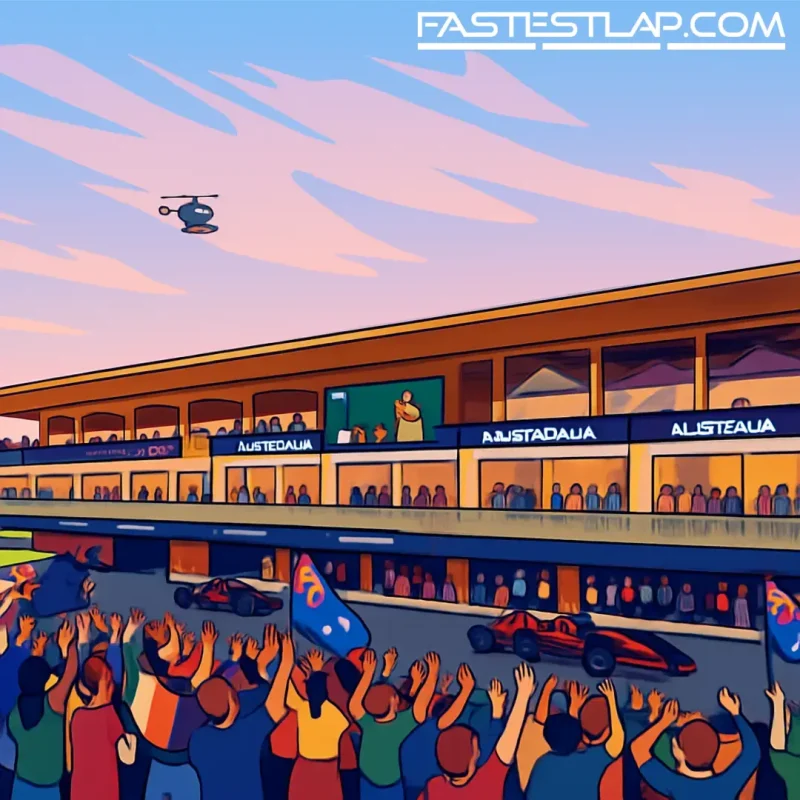Melbourne lifts the lid on a new Albert Park pit complex: bigger, smarter and finally fit for modern F1
After nearly three decades of making do with a “temporary” solution, Albert Park is getting the pit building it’s long deserved. Fresh images of the planned complex have landed, offering the first proper glimpse of how Melbourne’s front-of-house will look once the rebuild is complete for the 2028 Australian Grand Prix.
It’s the end of an era for the current structure, a 1996 quick-fix that outlived its shelf life as Formula 1 outgrew it. While it’s been tweaked over the years, it never caught up with the sport’s arms race of gleaming, purpose-built facilities elsewhere. Development Victoria, which is steering the project, didn’t mince words: “The current building does not meet the standards required by Formula 1 and the motorsport governing body, Fédération Internationale de l’Automobile, to host a Formula 1 event.”
This overhaul is part of Melbourne’s contract extension with F1 that keeps the race on the calendar through 2037. The brief is clear: future-proof the venue without losing the parkland character that makes the place what it is.
So, what’s coming? The new pit building will house 12 team garages plus two more for officials, alongside a new race control and upgraded admin spaces. That 14-garage total is a subtle tell: the support pit lane — originally built for Supercars and more recently pressed into service as Formula 2 and Formula 3 arrived on the bill — is set to remain a temporary setup for the undercards.
Up top, Melbourne’s going big on hospitality. Capacity jumps to 5,000 across new premium spaces, backed by full kitchens and amenities. It’s a clear nod to demand — the grandstands routinely evaporate in minutes — and a step up from the patchwork that’s served the paddock and corporate crowd since the ’90s.
Importantly for the locals who use the park the other 51 weeks of the year, the building has been conceived as more than a race-week bunker. Designed by architecture firm Woods Bagot, the facility will be usable beyond the Grand Prix. “What excites us most about this design is how it elevates both elite motorsport and grassroots community sport under one roof,” said project design lead Bruno Mendes. “We’ve engineered a facility that doesn’t just host one of the world’s premier racing events – it actively gives back to the local sporting community every day of the year.”
Icon Construction has the build contract, with preliminary works having kicked off in July. Inevitably, that means change to the landscape. Twenty-six trees have been removed to make way for the footprint, with plans to plant 120 new trees around the building and wider park as part of the offset strategy.
There’s a phased timeline to keep the Australian GP on the rails through the build. The existing pit complex is due to be demolished after the 2026 race. The new garages are targeted to be operational for 2027 — when teams would work out of the fresh bays — while a temporary hospitality structure (around 2,500 capacity) bridges the gap. The complete building, with all the bells and whistles, is scheduled to be ready in time for the 2028 event.
The choice to provision 12 full team boxes is worth clocking. F1 has run with 10 teams in recent seasons, but Melbourne is clearly thinking ahead, ensuring the facility won’t be playing catch-up if the grid expands during this contract window.
Beyond the render glow, the practical gains are obvious. Teams get modern workspaces, the race gets a control hub that meets current FIA requirements, and fans — who’ve packed Albert Park in record numbers — get better vantage points and amenities. It’s a necessary reset for a venue that’s only become more important to the championship, often staging the season’s early drama against that quintessential Melbourne backdrop.
Albert Park has always been a hybrid — part city park, part racing circuit, part pop-up festival. This project aims to keep that balance while dragging the nerve centre into the present. If the timelines hold, the 2027 edition will offer a teaser: new garages on the old bones, one foot in the future. Come 2028, the Australian Grand Prix will finally have a pit complex that matches its status on the calendar — and the view down pit lane should look every bit as sharp as the cars blasting past it.




